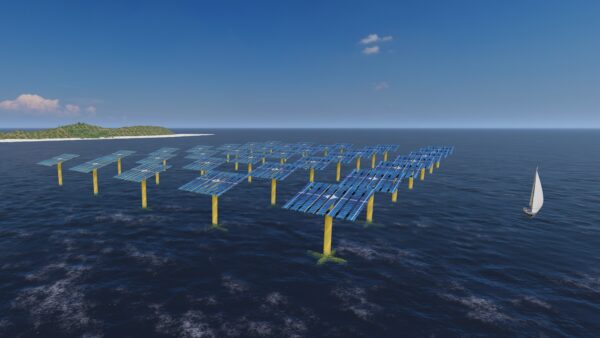Offshore floating PV system based on dual-axis tracker, tension leg platform – pv magazine International
Developed by scientists in Spain, the HelioSea system is reportedly able to ensure structural reliability in challenging marine environments. The research group proposed to use tension leg platforms that have been successfully applied to offshore drilling platforms, where stability is also paramount.
February 16, 2024
Researchers led by the University of Oviedo in Spain have developed a new floating PV system for applications in offshore waters.
“The novelty of the system lies in combining a dual-axis solar tracker with a mini tension leg platform (TLP),” the research’s corresponding author, Mario Lopez Gallego, told pv magazine. “To the best of our knowledge, this is the first time these two concepts have been proposed for a floating photovoltaic system, and HelioSea incorporates both. The former maximizes production, while the latter provides the required stability. TLPs are well-known in the oil & gas industry, where they have been successfully applied to drilling platforms, where stability is also paramount.”
The scientists explained that the TLP commonly consists of a deck structure, a buoyant hull based on vertical cylindrical columns, submerged horizontal pontoons, and tubular member bracing. The main advantage of this configuration is that the net buoyancy force exceeds the weight of the structure. This excess buoyancy, in turn, is balanced with taut tendons or tethers, which are able to vertically moor the floating platform.
The novel TLP comprises a mast and four pontoons connected to the sea bottom through taut mooring lines. “The proposed TLP substructure is independent and monolithic, thereby eliminating the requirement for mobile components and interconnections, apart from the mooring system,” the scientists said. “This feature ensures that the platform remains virtually horizontal with limited surge and sway excursions,” the group said, noting that the system is mobile and reusable, while ensuring minimal vertical motion.
According to the team, the TLP can withstand several degradation mechanisms such as erosion, abrasion, UV-induced deterioration, extreme temperature fluctuations, elevated humidity, and saltwater corrosion. It is fabricated with surface preparation and a dual-layer protective system via hot-dip galvanization.
” data-medium-file=”https://www.pv-magazine.com/wp-content/uploads/2024/02/Unbenannt-3-600×418.jpg” data-large-file=”https://www.pv-magazine.com/wp-content/uploads/2024/02/Unbenannt-3.jpg” class=”size-medium wp-image-244828″ src=”https://www.pv-magazine.com/wp-content/uploads/2024/02/Unbenannt-3-600×418.jpg” alt width=”600″ height=”418″ srcset=”https://www.pv-magazine.com/wp-content/uploads/2024/02/Unbenannt-3-600×418.jpg 600w, https://www.pv-magazine.com/wp-content/uploads/2024/02/Unbenannt-3-768×534.jpg 768w, https://www.pv-magazine.com/wp-content/uploads/2024/02/Unbenannt-3.jpg 1154w” sizes=”(max-width: 600px) 100vw, 600px”>
Image: University of Oviedo
The system prototype was conceived to have a capacity of 75 kW and host 138 bifacial PV panels with a rated power of 545 W. The modules are placed in 6 rows of 23 on a top-of-pole mount. Vertical and horizontal dual-axis trackers are included to automatically adjust two angles using servo motors throughout the day.
Both the TLP and the top-of-pole mount can be assembled separately and joined at the dockside before being taken offshore. “The reduced dimensions of HelioSea allow for consideration of shipping on a small-sized barge instead of towing,” the researchers explained.
They also said the system can offer a capacity density of 64 MW/km2 and a levelized cost of energy (LCOE) of €0.16($0.17)/kWh to €0.27/kWh. “While these values diverge significantly from those of ground-mounted solar systems, they align with a comparable order of magnitude to offshore floating wind systems and are notably lower than other marine renewable energies, such as wave and tidal energy,” they added.
Popular content
According to Lopez Gallego, the concept is currently in the early stages of development and has a technology readiness level (TRL) of 3. The TRL measures the maturity of technology components for a system and is based on a scale from one to nine, with nine representing mature technologies for full commercial application.
“The stability of the system in waves was confirmed in a wave tank with a scaled model, and structural verification of the main elements was also completed,” he concluded.
The researchers introduced the novel concept in the study “Advancing offshore solar energy generation: The HelioSea concept,” published in Applied Energy.
This content is protected by copyright and may not be reused. If you want to cooperate with us and would like to reuse some of our content, please contact: ed*****@pv*********.com.


